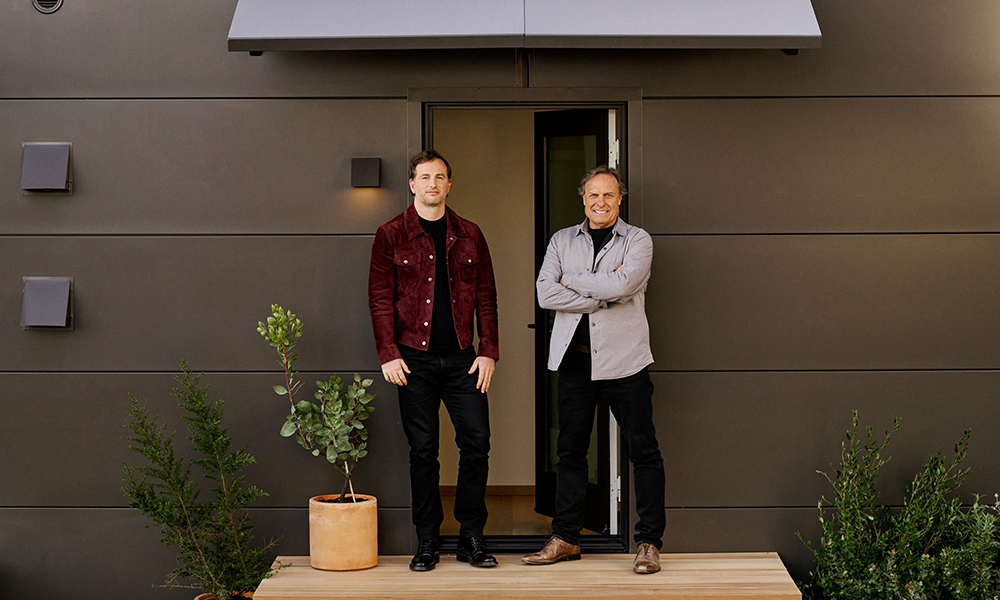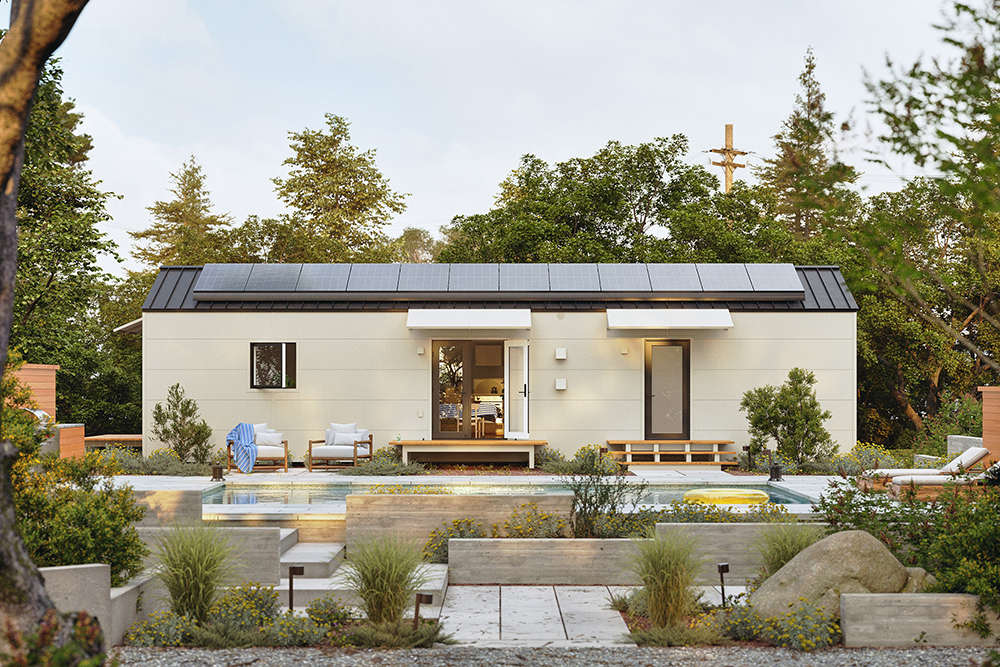爱彼迎联合创始人的蜕变:从租屋到造屋

爱彼迎(Airbnb)的联合创始人乔·杰比亚正在描述一栋房屋,听起来像是未来假期的度假屋:舒适、自然照明充足、玻璃顶棚和定制的家居,以及智能的设计美学。
杰比亚描述的并非是在爱彼迎上列出的出租屋,而是自己准备出售的房屋。实际上,他希望大量出售这类房屋,而且是越多越好。如果他获得成功,杰比亚期待这种类型的房屋就能够遍布加州乃至全美的后院,涵盖单室公寓、单卧和双卧房型。
杰比亚与Flex公司的前首席执行官迈克·麦克纳马拉共同创建的Samara,耗费了数年的时间来完善这些房屋的设计。他们认为,买家们已经做好了线上订购的准备,随后公司将进行交付,并在其地产上进行安装或预组装。
杰比亚于2022年夏季辞去了爱彼迎的运营职务,但仍然担任公司董事。杰比亚对《财富》杂志表示:“加州各地需要更多空间的家庭都在寻找这类解决方案。”他称跨代居住、居家工作革命以及房屋所有者看好租赁收入等趋势都在推高这一需求。杰比亚说:“我们沿用了爱彼迎在旅游领域的理念,即‘省去消费者的麻烦,为消费者带来便利’。”
从技术层面来讲,Samara修建的房屋属于ADU(附属住宅单位):该术语涵盖后院屋舍、小屋以及一些房屋所有者主要居所旁边的耳房。Samara的理念是大规模建造ADU,从而让房屋所有者可以便捷地在自家地产上建房,无需费力地与承包商打交道,或履行繁杂的地方许可手续。杰比亚将其比作是在线预订特斯拉(Tesla)电动汽车。“人们登录网站,进行选择,按照自身喜好定制,然后点击预订。”
这家位于旧金山的公司的首款产品名为Backyard,面积从420平方英尺(约39平方米)到690平方英尺(约64平方米)不等,价格在26.9万美元至36.9万美元之间。Samara自2022年开始便已经悄然在其网站上出售上述房屋,不断地改进其流程,而且在拿到新资本后,公司如今计划全面启动其销售和营销举措。
Samara公司于10月30日宣布,已经在A轮筹集了4,100万美元的资金,由风投公司Thrive Capital领投,参与者涵盖各类投资者,例如8VC、General Catalyst、New Legacy、SV Angel和爱彼迎,以及迈克尔·戴尔、爱彼迎的联合创始人布莱恩·切斯基和柏思齐(Nathan Blecharczyk)。
杰比亚表示,这笔资金有助于Samara拓展其业务,包括制造、营销和研发。“我们必须对业务规模进行大幅扩张。”
在工厂内修建房屋
Samara意为带翅膀的种子,而这个翅膀,按照杰比亚的话来说就是整合至种子的一项技术,让种子能够从树上掉落后像直升飞机一样飞翔。这对一家源于2016年爱彼迎内部研发团组的公司而言是一个十分贴切的名字。在2022年春天,该部门在杰比亚和麦克纳马拉的资助下,脱离了爱彼迎,成为了一家独立公司,而且爱彼迎也是其投资者。
与利用现有房地产让爱彼迎得以壮大的分享经济原则对比,Samara基本上属于“老一套”的实体产品生产经济模式,因此那些杂乱的库存、供应链和运输挑战也就接踵而至。
尽管这是一项高难度赛事,但麦克纳马拉依然知难而上。这位Flex的前首席执行官对全球复杂的供应链可谓是了如指掌。Flex是一家电子产品制造商,其组装的产品从笔记本电脑一直到医院X光机器,营收达300亿美元。毕业于罗德岛设计学院(Rhode Island School of Design)的杰比亚谈论的是产品的气氛和氛围,而麦克纳马拉关心的则是“堆叠利润”、“资本支出”和“工时差异”。
麦克纳马拉称,由于是在工厂内部建造ADU,Samara实现了环境的可控,而且不会受制于变化莫测的天气,同时还会受益于标准化的材料和生产成本。他说:“与现场搭建的普通承包商相比,我们房屋的成本效益将得到不断提升。”

Samara有着很多的供应商,供应的产品从定制厨房家具材料一直到屋顶太阳能板。这家公司不愿意透露其生产流程,但自称已经明确,该模式奏效的前提是,制造工厂与房屋目的地的距离应该在500英里(约804.672千米)至1,000英里(约1,609.344千米)的范围内。这个距离可以让Samara覆盖不俗的地域范围,涵盖加州全境以及西南部分地区。为了深入美国的阳光地带(这也是公司最终打算要做的事情),麦克纳马拉称公司就得建造更多的生产工厂。
这位Samara的首席执行官并没有详细介绍公司的财务模式,但他表示,“我们完全能够预测公司何时可以实现自由现金流收支平衡。”
与爱彼迎相比,另一个有趣之处在于,尽管短期房屋租赁服务自诞生以来便引发了当地政府的反感,Samara似乎赢得了部分监管机构的芳心。在加州和其他州寻找缓解房屋短缺的途径之际,ADU便成为了十分受欢迎的补救举措。加州最近几年通过了多部法律,也让当地政府通过地方区划法规阻止ADU建造的行为难上加难。今年10月的早些时候,加州的州长加文·纽森签署了一项法令,允许ADU单独出售,不用与地产的主居所捆绑,这意味着ADU如今能够像公寓那样进行买卖。
不过,即便有了Samara这类公司的帮助,在地产上增加一栋ADU本质上要比提一辆新车复杂得多。公司称,从点击“购买”到获得其新家的钥匙平均需等待七个月的时间。首先,公司代表必须实地查看以确定是否适合修建ADU。在此之后还得拿到许可,进行土壤调查,并完成其他准备工作。Samara称这些步骤需要三个月至四个月的时间。最后,将房屋放置在客户的后院需要约30天的时间,其中包括地基准备以及铺设水、废水管道和电线。麦克纳马拉称,一旦吊车将房屋放置在地基之上后,仅需一个小时进行固定和连接。
事实上,正是因为这项业务的流程异常繁琐,机遇才会应运而生,客户会将一切事务交由Samara处理。
带有灵魂的小居所
然而,我们并不清楚消费者是否愿意在这类大规模生产的迷你房屋内居住。杰比亚认为,当前的各种社会趋势、Samara对建筑和审批流程的端对端处理,以及Backyard房屋美轮美奂的设计,将让这一理念博得消费者的青睐。
公司提供四种不同版本的产品,并在设计上进行调整,然后形成如今出售的Backyard版本。杰比亚称:“如何打造一个拥有灵魂的小空间?这才是我们追求的目标。”他将该产品称之为“空白画布”,可以让所有者按照不断变化的需求进行调整。
Backyard采用了钢质屋顶、工程橡木制作的硬木地板,以及6×2型号的隔热钢构架。内墙采用了类似于纸面石膏板的墙面,这意味着居住者能够悬挂照片、粉刷墙面,并开展可以在普通居所里进行的其他定制项目。房屋将与主居所的电力系统相连,或使用自带的太阳能电池板供电。
最终,Samara希望为不同地区和气候打造不同版本的ADU。当前Backyard产品的设计仅适用于温暖气候,并不适用于下雪环境(自然也就不适用于那些寻求购买廉价山中住所的滑雪和滑雪板爱好者。)公司有计划在未来生产适用于飓风频发地区的住所,有助于其进军像佛罗里达州这样的目标市场。
麦克纳马拉称,目前,仅加州一州便能够为ADU提供2,000亿美元的潜在市场。顾名思义,Samara的Backyard(后院)产品针对的就是住所后院。然而,麦克纳马拉也在憧憬,客户会购买多套房屋单元,然后并排安装在公园附近的游乐设施中,或将其用作公司办公场所。他说:“在这一领域,我们将迎来很长的甜蜜期。”(财富中文网)
译者:冯丰
审校:夏林
爱彼迎(Airbnb)的联合创始人乔·杰比亚正在描述一栋房屋,听起来像是未来假期的度假屋:舒适、自然照明充足、玻璃顶棚和定制的家居,以及智能的设计美学。
杰比亚描述的并非是在爱彼迎上列出的出租屋,而是自己准备出售的房屋。实际上,他希望大量出售这类房屋,而且是越多越好。如果他获得成功,杰比亚期待这种类型的房屋就能够遍布加州乃至全美的后院,涵盖单室公寓、单卧和双卧房型。
杰比亚与Flex公司的前首席执行官迈克·麦克纳马拉共同创建的Samara,耗费了数年的时间来完善这些房屋的设计。他们认为,买家们已经做好了线上订购的准备,随后公司将进行交付,并在其地产上进行安装或预组装。
杰比亚于2022年夏季辞去了爱彼迎的运营职务,但仍然担任公司董事。杰比亚对《财富》杂志表示:“加州各地需要更多空间的家庭都在寻找这类解决方案。”他称跨代居住、居家工作革命以及房屋所有者看好租赁收入等趋势都在推高这一需求。杰比亚说:“我们沿用了爱彼迎在旅游领域的理念,即‘省去消费者的麻烦,为消费者带来便利’。”
从技术层面来讲,Samara修建的房屋属于ADU(附属住宅单位):该术语涵盖后院屋舍、小屋以及一些房屋所有者主要居所旁边的耳房。Samara的理念是大规模建造ADU,从而让房屋所有者可以便捷地在自家地产上建房,无需费力地与承包商打交道,或履行繁杂的地方许可手续。杰比亚将其比作是在线预订特斯拉(Tesla)电动汽车。“人们登录网站,进行选择,按照自身喜好定制,然后点击预订。”
这家位于旧金山的公司的首款产品名为Backyard,面积从420平方英尺(约39平方米)到690平方英尺(约64平方米)不等,价格在26.9万美元至36.9万美元之间。Samara自2022年开始便已经悄然在其网站上出售上述房屋,不断地改进其流程,而且在拿到新资本后,公司如今计划全面启动其销售和营销举措。
Samara公司于10月30日宣布,已经在A轮筹集了4,100万美元的资金,由风投公司Thrive Capital领投,参与者涵盖各类投资者,例如8VC、General Catalyst、New Legacy、SV Angel和爱彼迎,以及迈克尔·戴尔、爱彼迎的联合创始人布莱恩·切斯基和柏思齐(Nathan Blecharczyk)。
杰比亚表示,这笔资金有助于Samara拓展其业务,包括制造、营销和研发。“我们必须对业务规模进行大幅扩张。”
在工厂内修建房屋
Samara意为带翅膀的种子,而这个翅膀,按照杰比亚的话来说就是整合至种子的一项技术,让种子能够从树上掉落后像直升飞机一样飞翔。这对一家源于2016年爱彼迎内部研发团组的公司而言是一个十分贴切的名字。在2022年春天,该部门在杰比亚和麦克纳马拉的资助下,脱离了爱彼迎,成为了一家独立公司,而且爱彼迎也是其投资者。
与利用现有房地产让爱彼迎得以壮大的分享经济原则对比,Samara基本上属于“老一套”的实体产品生产经济模式,因此那些杂乱的库存、供应链和运输挑战也就接踵而至。
尽管这是一项高难度赛事,但麦克纳马拉依然知难而上。这位Flex的前首席执行官对全球复杂的供应链可谓是了如指掌。Flex是一家电子产品制造商,其组装的产品从笔记本电脑一直到医院X光机器,营收达300亿美元。毕业于罗德岛设计学院(Rhode Island School of Design)的杰比亚谈论的是产品的气氛和氛围,而麦克纳马拉关心的则是“堆叠利润”、“资本支出”和“工时差异”。
麦克纳马拉称,由于是在工厂内部建造ADU,Samara实现了环境的可控,而且不会受制于变化莫测的天气,同时还会受益于标准化的材料和生产成本。他说:“与现场搭建的普通承包商相比,我们房屋的成本效益将得到不断提升。”
Samara有着很多的供应商,供应的产品从定制厨房家具材料一直到屋顶太阳能板。这家公司不愿意透露其生产流程,但自称已经明确,该模式奏效的前提是,制造工厂与房屋目的地的距离应该在500英里(约804.672千米)至1,000英里(约1,609.344千米)的范围内。这个距离可以让Samara覆盖不俗的地域范围,涵盖加州全境以及西南部分地区。为了深入美国的阳光地带(这也是公司最终打算要做的事情),麦克纳马拉称公司就得建造更多的生产工厂。
这位Samara的首席执行官并没有详细介绍公司的财务模式,但他表示,“我们完全能够预测公司何时可以实现自由现金流收支平衡。”
与爱彼迎相比,另一个有趣之处在于,尽管短期房屋租赁服务自诞生以来便引发了当地政府的反感,Samara似乎赢得了部分监管机构的芳心。在加州和其他州寻找缓解房屋短缺的途径之际,ADU便成为了十分受欢迎的补救举措。加州最近几年通过了多部法律,也让当地政府通过地方区划法规阻止ADU建造的行为难上加难。今年10月的早些时候,加州的州长加文·纽森签署了一项法令,允许ADU单独出售,不用与地产的主居所捆绑,这意味着ADU如今能够像公寓那样进行买卖。
不过,即便有了Samara这类公司的帮助,在地产上增加一栋ADU本质上要比提一辆新车复杂得多。公司称,从点击“购买”到获得其新家的钥匙平均需等待七个月的时间。首先,公司代表必须实地查看以确定是否适合修建ADU。在此之后还得拿到许可,进行土壤调查,并完成其他准备工作。Samara称这些步骤需要三个月至四个月的时间。最后,将房屋放置在客户的后院需要约30天的时间,其中包括地基准备以及铺设水、废水管道和电线。麦克纳马拉称,一旦吊车将房屋放置在地基之上后,仅需一个小时进行固定和连接。
事实上,正是因为这项业务的流程异常繁琐,机遇才会应运而生,客户会将一切事务交由Samara处理。
带有灵魂的小居所
然而,我们并不清楚消费者是否愿意在这类大规模生产的迷你房屋内居住。杰比亚认为,当前的各种社会趋势、Samara对建筑和审批流程的端对端处理,以及Backyard房屋美轮美奂的设计,将让这一理念博得消费者的青睐。
公司提供四种不同版本的产品,并在设计上进行调整,然后形成如今出售的Backyard版本。杰比亚称:“如何打造一个拥有灵魂的小空间?这才是我们追求的目标。”他将该产品称之为“空白画布”,可以让所有者按照不断变化的需求进行调整。
Backyard采用了钢质屋顶、工程橡木制作的硬木地板,以及6×2型号的隔热钢构架。内墙采用了类似于纸面石膏板的墙面,这意味着居住者能够悬挂照片、粉刷墙面,并开展可以在普通居所里进行的其他定制项目。房屋将与主居所的电力系统相连,或使用自带的太阳能电池板供电。
最终,Samara希望为不同地区和气候打造不同版本的ADU。当前Backyard产品的设计仅适用于温暖气候,并不适用于下雪环境(自然也就不适用于那些寻求购买廉价山中住所的滑雪和滑雪板爱好者。)公司有计划在未来生产适用于飓风频发地区的住所,有助于其进军像佛罗里达州这样的目标市场。
麦克纳马拉称,目前,仅加州一州便能够为ADU提供2,000亿美元的潜在市场。顾名思义,Samara的Backyard(后院)产品针对的就是住所后院。然而,麦克纳马拉也在憧憬,客户会购买多套房屋单元,然后并排安装在公园附近的游乐设施中,或将其用作公司办公场所。他说:“在这一领域,我们将迎来很长的甜蜜期。”(财富中文网)
译者:冯丰
审校:夏林
Airbnb cofounder Joe Gebbia describes a house that sounds like a nice spot for an upcoming vacation: it’s cozy, with lots of natural light and a high gable ceiling, bespoke custom furniture, and a smart design aesthetic.
Gebbia isn’t describing a listing on Airbnb. He’s talking about a house he wants to sell. Actually, he wants to sell a lot of these houses; so many, that if he’s successful, Gebbia envisions a version of the house—in studio, one-bedroom, and two-bedroom configurations—in backyards throughout California, and eventually the U.S.
Samara, the startup that Gebbia cofounded with former Flex CEO Mike McNamara, has spent years perfecting the design of these houses and is betting that buyers are ready to order them online, to be delivered and installed—pre-assembled—on their property.
“Families across California that need space are looking for these solutions,” Gebbia tells Fortune, citing multigenerational living, the work from home revolution, and homeowners’ interest in rental income as among the trends driving the need. “We’re taking the same playbook that Airbnb brought to the travel space of ‘make it simple, make it easy for the consumer,’” says Gebbia, who left his operational role at Airbnb in the summer of 2022 but remains on the board of directors.
Technically the houses Samara is building are what’s called ADUs, or accessory dwelling units: a term that encompasses the backyard cottages, casitas, and in-law units that sit alongside some homeowners’ primary residence. The idea behind Samara is to mass produce ADUs, making it easy for a homeowner to add one to their property without the headaches of working with a contractor or dealing with the local permitting process. Gebbia likens it to ordering a Tesla electric car online—“You go online, you pick your options, you configure it to your tastes, and you hit order.”
The San Francisco-based company’s initial product—called Backyard—ranges from 420-square feet to 690-square feet, and costs between $269,000 and $369,000. Samara has been quietly offering the homes on its website since last year, fine tuning the process, and with an infusion of capital, now plans to ramp up its sales and marketing efforts.
On October 30, Samara announced that it has raised $41 million in funding in a Series A round led by VC firm Thrive Capital, with participation from a variety of investors including 8VC, General Catalyst, New Legacy, SV Angel, and Airbnb, as well as Michael Dell and Airbnb cofounders Brian Chesky and Nathan Blecharczyk.
The money will help Samara expand its operations, including manufacturing, marketing, and research and development, says Gebbia. “We’ve got to scale a lot of dimensions of the business.”
Building a house inside a factory
Samara is the name of a seed with a wing. The wing—a piece of technology that’s integrated into the seed, as Gebbia describes it—lets the seed fly like a helicopter as it falls from its tree. It’s an apt name for a company that began as Airbnb’s in-house R&D group back in 2016. In the spring of 2022, the unit was spun out of Airbnb as an independent company, funded by Gebbia and McNamara, along with Airbnb as an investor.
In contrast to the sharing economy principles that let Airbnb thrive by leveraging existing real estate, Samara is very much in the “old” economy business of manufacturing a physical product, with all the messy inventory, supply chain, and transportation challenges that come with it.
It’s a very different ball game, but that’s where McNamara comes in. The former CEO of Flex, a $30 billion-in-revenue electronics manufacturer that assembles everything from laptops to hospital X-ray machines, is well versed in the intricacies of global supply chains. While Gebbia, a graduate of Rhode Island School of Design, talks about the product’s atmosphere and ambiance, McNamara speaks in the language of “stacked margins,” “capital outlay,” and “time variance.”
By building the ADUs inside a factory, Samara has a controlled environment that’s not subject to unpredictable weather, while also benefiting from standardized material and production costs, McNamara says. “Our unit is going to be continually more cost effective relative to a general contractor building in the field,” he says.
Samara is working with a long list of suppliers that provide everything from the material for custom kitchen furniture to rooftop solar panels. The company won’t divulge much about its production process, but says it has determined that the manufacturing facility must be between 500 miles and 1,000 miles away from a houses’ destination for the model to work. That would allow Samara to cover a decent swath of territory that includes all of California, and some part of the Southwest. To push further into the U.S. sunbelt, as the company eventually hopes to do, McNamara says more facilities would be needed.
The Samara CEO won’t go into details on the company’s financial model but says “we have a very foreseeable timeframe that we can be free cash flow break even.”
Another interesting contrast with Airbnb is that while the short-term home-rental service has caused friction with local governments since its inception, Samara appears to have some favorable regulatory tailwinds blowing its way. As California and other states look for ways to ease the housing shortage, ADUs have become a popular remedy. California has passed several laws in recent years making it harder for local municipalities to block ADU construction on the basis of local zoning codes. Earlier October, California Gov. Gavin Newsom signed a law allowing ADUs to be sold separately from a property’s main residence, meaning ADUs can now be bought and sold like condos.
Still, even with the help of a service like Samara, adding an ADU to a property is inherently more complex than taking delivery of a new car. The company says the average time from clicking “buy” to getting the keys of one of its homes is about seven months. First, a company representative must visit the property to determine whether it’s suitable. After that there’s a process of getting permits, taking soil surveys, and completing other preparatory steps—a phase Samara says takes three to four months. The final step—placing the house in a customer’s backyard—requires about 30 days, which includes preparing the foundation and setting up the water, wastewater, and electrical lines. Once a crane lowers the house onto the foundation, it takes just an hour and a half to bolt it and connect it, McNamara says.
The fact that the process is such a pain in the butt, McNamara and Gebbia say, is why it’s an opportunity; the customer lets Samara handle everything.
A small living space with soul
Whether consumers will want to live in such mass-produced mini dwellings remains to be seen. Gebbia believes the current confluence of societal trends, Samara’s end-to-end handling of the construction and permitting process, and the eye-pleasing design of the Backyard will make the concept click with consumers.
The company worked on four different versions of the product, making various design changes, before arriving at the version of the Backyard that’s now on sale. “How do you create a small space that has soul? That’s what we were after,” Gebbia says, describing the unit as a “blank canvas” that owners can adjust to their changing needs.
The Backyard has a steel roof, a hardwood floor made of engineered oak wood, and is built from a structure of insulated steel six-by-twos. The interior walls have a drywall-like finish, which means residents can hang pictures, paint the walls, and do any of the other customization projects possible in a normal home. The unit can be connected to the main residence’s electrical system or run on its own solar panels.
Eventually Samara hopes to produce different versions of ADUs for different regions and climates. The current Backyard is designed only for warm weather and is not suitable for snow (no doubt to the chagrin of skiers and snowboarders seeking an option to own cheap mountain lodging). The company has plans to eventually produce a unit suitable for hurricane-prone regions, which would allow it to target markets like Florida.
For the time being, California alone offers a $200 billion total addressable market for ADUs, McNamara says. As the name suggests, Samara’s Backyard product was designed to sit in a residential backyard. But McNamara envisions situations in which customers purchase multiple units to install side-by-side in a recreational facility near a park or as corporate housing. “We’re going to be happy here for a long time,” he says.













